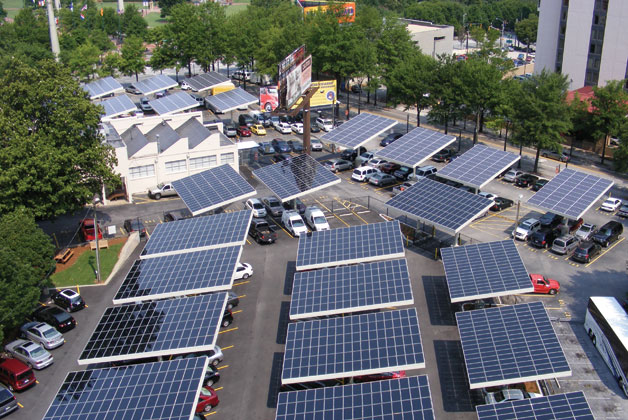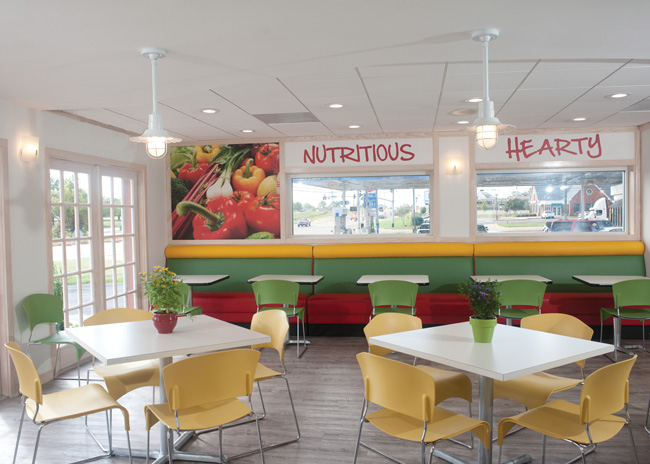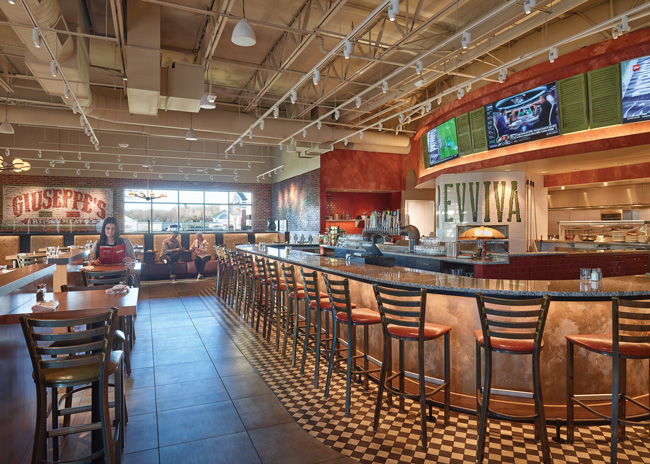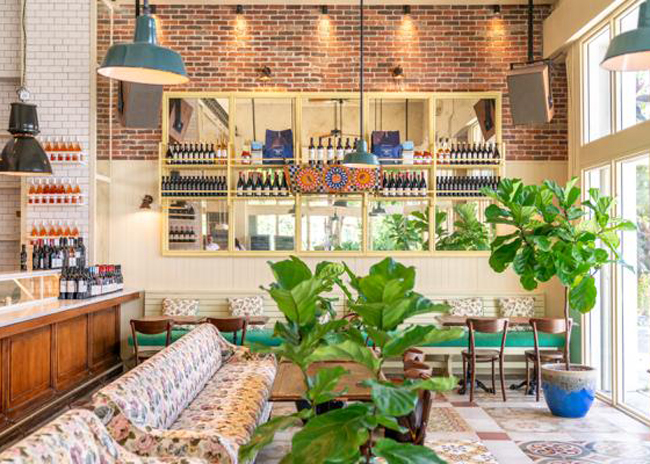Many restaurants have gone green on the inside, but what about the outside?
With plenty of energy-efficient equipment choices, skilled designers and access to information on sustainable initiatives for the indoors, it can be easy to overlook the potential cost savings and eco-friendly brand strengthening that can come from such initiatives outside a building's walls.
Chains such as Chipotle, Wendy's and Applebee's, to name a few, have found such benefits through LEED-certified building, and the group of restaurants engaging in LEED-driven outdoor green initiatives continues to grow. But LEED certification isn't necessary to reap the rewards.
From solar panels and other forms of alternative energy to green or white roofs, rainwater collection, drought-resistant landscaping and recycled building materials, looking at sustainability in a more holistic way can further build a restaurant's image and lead to major utility bill savings.
Alternative Energy
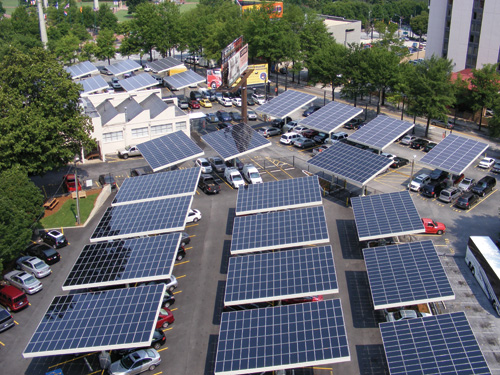 Ted's Montana Grill solar panelsFor Ted's Montana Grill, installing 25 solar panels in the parking lot of its main restaurant and corporate headquarters in Atlanta 2 years ago was simply a natural extension of the chain's overall mission. "Alternative energy like solar panels is worth it as an investment for us because we're emotionally attached to it; Ted's wants to be an example in the efforts of sustainability," says George McKerrow Jr., co-founder and CEO of Ted's Montana Grill.
Ted's Montana Grill solar panelsFor Ted's Montana Grill, installing 25 solar panels in the parking lot of its main restaurant and corporate headquarters in Atlanta 2 years ago was simply a natural extension of the chain's overall mission. "Alternative energy like solar panels is worth it as an investment for us because we're emotionally attached to it; Ted's wants to be an example in the efforts of sustainability," says George McKerrow Jr., co-founder and CEO of Ted's Montana Grill.
A strong supporter and investor in alternative energy, Ted's formed a partnership with its utility provider to set up the solar — or photovoltaic — panels as a way to further save precious resources. The panels generate enough power to supply a solid percentage of the 9-story building, which includes the 4,500-square-foot, 110-seat restaurant on the ground floor and office space above. Though exact numbers are difficult to measure, McKerrow estimates that the panels generate about 200,000 kWh annually for the restaurant alone and save roughly 20 percent on the building's annual utility bill.
Prior to the headquarters installation, Ted's Montana Grill also installed 14 solar panels in 2005 on the roof of its Tallahassee, Fla., restaurant. These panels generate 5 percent to 8 percent of the total energy the building uses, savings Ted's realizes in the form of a credit on the restaurant's utility bill. McKerrow estimates that move has saved the restaurant between $2,500 and $4,000 a year on a $48,000-a-year electric bill.
"The thing that's wonderful about solar panels is that they take little maintenance once they're installed," McKerrow says. "It's not like an ongoing generator that can have frequent breakdowns. We think clean, alternative energy is the long-term solution to global warming and pollution. When you live in an area where we do, which has almost 100 percent electricity generated from coal burning, we do what we can to be on the leading edge." Many states now offer rebates for solar panels and other alternative energy investments as a way to cut down on higher costs up front, McKerrow points out.
Darden Restaurants installed a similar photovoltaic system on the roof of its Orange County, Fla., Restaurant Support Center, generating a whopping 1.1 million watts of power. It's expected to supply 18 percent of the center's annual energy needs, and the company plans to expand its capacity to provide an additional 40,000 watts.
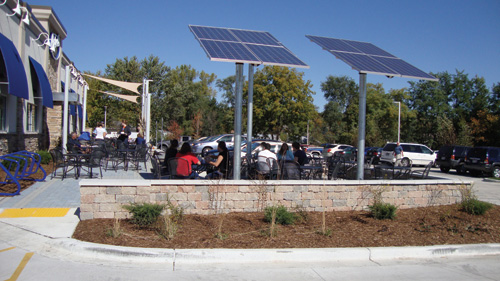 People like the shade of the panels at CulversAnd, Culver's installed photovoltaic panels at its LEED-NC Silver restaurant in Baraboo, Wis. The panels, set over the location's patio, collect solar energy and provide shading, according to Jon Sandeman, LEED Green Associate and project architect for Culver Franchising System Inc., which oversees 470 franchised stores. "We don't need umbrellas anymore, either," he says. Culver's Baraboo store is a company-owned location built in 2011, and it earned LEED certification in January of this year.
People like the shade of the panels at CulversAnd, Culver's installed photovoltaic panels at its LEED-NC Silver restaurant in Baraboo, Wis. The panels, set over the location's patio, collect solar energy and provide shading, according to Jon Sandeman, LEED Green Associate and project architect for Culver Franchising System Inc., which oversees 470 franchised stores. "We don't need umbrellas anymore, either," he says. Culver's Baraboo store is a company-owned location built in 2011, and it earned LEED certification in January of this year.
Sandeman estimates the panels have saved the restaurant 11 percent on electricity bills as well as 12 percent on gas compared to similar stores in climates like those in the upper Midwest, though he guesses restaurants in Arizona and other sun-drenched states could save much more. "We're predicting a three- or four-year return on investment," he adds.
Whereas Ted's, Darden and Culver's installed solar panels to divert from grid energy use, The Cheesecake Factory installed the panels as a way to divert hot water use. Twenty rooftop collectors, measuring 4 feet by 10 feet, at its Pleasanton, Calif., location capture energy to heat water to 150 degrees F or 160 degrees F as a replacement to a traditional gas-powered booster; this generates an energy savings of between 9.52 and 10.03 therms per day. The move also offsets 15 percent of the hot water load. Over the course of the year it first installed the panels, The Cheesecake Factory unit saved more than $2,000 in energy costs and nearly 60,000 pounds of C02.
Culver's also looked into wind turbines, but the fact that the Baraboo location sits at the bottom of a hill made wind collection difficult. Chipotle is said to have experimented with wind turbines, but these are not always allowed in certain jurisdictions. Instead, some restaurants buy wind power credits through their local utility companies in an effort to support "off-the-grid" energy.
Geothermal systems are another burgeoning area for alternative energy. These alternative energy systems drill down to naturally temperate groundwater in the Earth's core and circulate it through a building as a natural coolant or warming source. Culver's also looked into this form of energy, but it proved prohibitive because of strong bedrock in the area.
Green Building Design
Part of investing in outside sustainable features involves minimizing waste and environmental impact during the construction process itself. It's the complete package that helps restaurants reduce their carbon footprint overall.
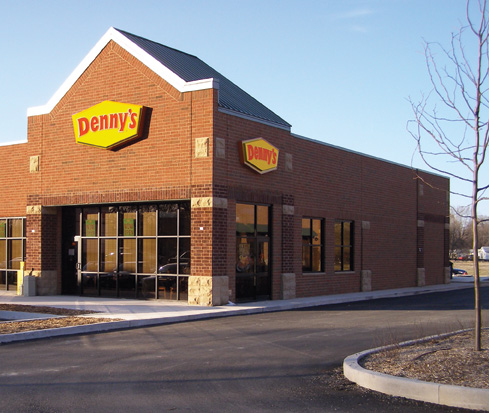 Denny's in Joliet One Denny's franchisee in Joliet, Ill., the chain's first LEED-certified location, looked to use as many reclaimed materials and renewable resources as possible, recycling about 80 percent of the waste produced during construction. "Our planter boxes are made from volcanic ash, and our ceiling, carpeting and tiling are all made from recycled materials," says franchisee Joe Terrell.
Denny's in Joliet One Denny's franchisee in Joliet, Ill., the chain's first LEED-certified location, looked to use as many reclaimed materials and renewable resources as possible, recycling about 80 percent of the waste produced during construction. "Our planter boxes are made from volcanic ash, and our ceiling, carpeting and tiling are all made from recycled materials," says franchisee Joe Terrell.
Other simple, sustainable steps during building and construction can help indirectly cut down on energy costs and carbon footprint. At Culver's, for instance, simply painting the roof white and using white concrete with plenty of shading trees in the parking areas instead of asphalt or traditional black shingles helps prevent a "heat island effect," cutting down on the overall heat of the building and property, says Sandeman.
Focusing on insulation represents another easy step that helps save energy from the outside in. By increasing the wall insulation to 36 percent from the traditional 14 percent to 20 percent range, Denny's Joliet location was able to lower expensive heating and cooling costs. "This is especially helpful during our promotional periods," Terrell says. "During the Superbowl last year we gave away free Grand Slams, and the line of people caused the doors to be held open in the middle of February." As a result, the heating system went into overdrive, and the restaurant actually had to kick in the air conditioning, thus raising the utility bills even further.
Selection of the site itself can have positive, sustainable effects. Architects know that by positioning a building in a particular way, they can bring in more natural light throughout the space and use fewer artificial, energy-draining bulbs. Denny's installed a series of 4-by-4-foot skylights, built by Amish craftmakers in Arthur, Ill., that use mirrors to draw natural light, reducing the need for artificial light by 40 percent during daytime hours. Even kitchen workers in the back of the house can benefit from the natural light as a result of these skylights, Terrell says.
Culver's gained credit for "Community Connectivity" in its application for LEED certification by building its Baraboo restaurant on an existing urban lot within walking distance of 10 basic services, including other businesses, thereby cutting down on excess vehicle use while encouraging more walking and biking. The restaurant also used reclaimed pavers for its patio and, like Denny's, implemented a construction waste management plan during construction, according to Sandeman.
For new-build restaurants, Ted's has sought to strategically connect with sustainability-focused lifestyle centers. "We're building a new restaurant in Roswell, Ga., and the center definitely thinks outside of the box compared to others," says McKerrow, referring to the center's central collection point for compostables, recyclables and fry oil pumped from the site's restaurants.
"These shopping centers and developers are starting to put sustainability in their forecasted plans; we're starting to think more in advance what we can do to run a more sustainable business, and I only see more of these types of centers in the future," McKerrow adds.
Rainwater Collection, Landscaping and Irrigation
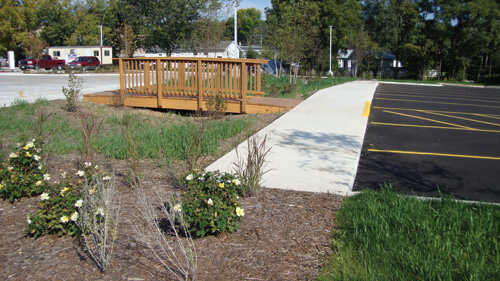 Culvers's native plantings and pondCollecting and using rainwater for irrigation and other gray water needs can help a restaurant offset excess water usage costs just as much as water-efficient equipment and accessories such as aerators, low-flow spray valves and so on.
Culvers's native plantings and pondCollecting and using rainwater for irrigation and other gray water needs can help a restaurant offset excess water usage costs just as much as water-efficient equipment and accessories such as aerators, low-flow spray valves and so on.
Culver's was able to reduce storm water runoff by 43 percent by installing large bioretention spaces to collect and divert storm water to its natural landscaping, which amounts to about 40 percent of green outdoor space on the property, says Sandeman. "By making sites like Baraboo pervious enough to sponge up excess storm water and keep it on-site for our landscaping, that also helps prevent flooding in the community around us," he says.
Fifth Group Restaurants in Atlanta also collects rainwater as well as snow and ice melt for irrigation and toilet water. "When we built the restaurant [Lure in Midtown] we made sure that all the water would be able to be collected," says partner Steve Simon. The rainwater and melted snow get collected on the roof and patio and plumbed underground into a 3,000-gallon, 25-foot long, 4-foot-tall rainwater "pillow," or rubber membrane, in a crawlspace of the restaurant's basement. The runoff then goes through a series of UV light filters so it can be used to flush toilets and water landscaping.
Lure's system, installed slightly more than a year ago, is more complicated than most, but Simon says the payoff makes it worth the investment of about $20,000, not including rebates. "In the first couple of months we saved roughly 18,000 gallons of water, and our water bill compared to other restaurants of a comparable size in our area is at least 30 percent less, which amounts to a savings of $5,000 to $6,000 per month," says Simon. "We were hoping the system would pay back in three or four years, but at this rate, it will pay itself back in just one year."
Using native plants that don't require excess watering to begin with only further reduces water costs.
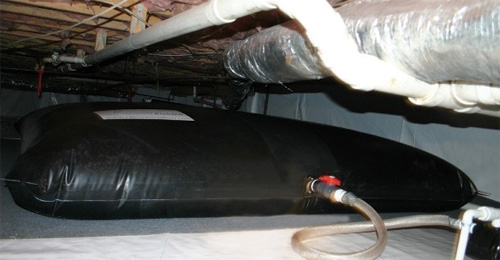 Rainwater pillow"By using natural prairie grass, we were able to achieve 'xeriscape' landscaping, meaning there is no need for irrigation," says Terrell of Denny's Joliet location. As a result of its indoor and outdoor water-saving initiatives, Denny's Joliet location was able to reduce its total water and sewage connection fees by $25,000 to an almost negligible cost, Terrell says.
Rainwater pillow"By using natural prairie grass, we were able to achieve 'xeriscape' landscaping, meaning there is no need for irrigation," says Terrell of Denny's Joliet location. As a result of its indoor and outdoor water-saving initiatives, Denny's Joliet location was able to reduce its total water and sewage connection fees by $25,000 to an almost negligible cost, Terrell says.
With Ted's, rainwater cisterns for collection are all about "back to the future," says McKerrow. "This was something that was done on a regular basis 100 years ago, but seemed to have gone by the wayside as water was dumped into the city sewer system."
The chain takes water sustainability efforts a step further by partnering with the Bonneville Environmental Foundation to offset a portion of the costs to restore recreational and fishing areas in the Colorado River basin damaged by years of drought. The water restoration certificates purchased by Ted's will restore 5 million gallons of water to the river basin over 2 years, McKerrow says.
Lots and Lighting
Aside from using white concrete (which McKerrow says can take 10 to 20 degrees off a lot's temperature), permeable pavers and more green space, native landscaping and bike racks, restaurants are finding other ways to cut costs and environmental impact in one of their primary outdoor spaces.
Denny's installed a series of LED lights for its parking lot to save energy costs. "In the past we used 6 400-watt bulbs around the building to light the exterior, but now I have 18 LEDs using a fraction of the amount of energy," Terrell says. "My utility bill was huge, so that's why I invested in these lights and other green initiatives in the first place," he says. "I figure I'm now spending $20,000 less per year on these costs."
Installing LEDs outside is an easy first step, Terrell adds. Once known for producing harsh light, LED bulbs have improved in recent years. And, for exterior use, Terrell points out, brightness is more important than color quality anyway. Equipped with daytime sensors, the combination of indoor and outdoor LED bulbs saves about 90 percent compared to the previous non-LED lights. This represents a reduction of more than 2,000 watts per hour.
Denny's Joliet location also plans to install a two-car charging station in its parking lot, a burgeoning outdoor sustainability initiative among restaurants nationwide. Through a program endorsed by the Environmental Protection Agency, a station manufacturer will provide the restaurant with the unit, and it's up to Denny's to wire the electricity to it. The restaurant will split the costs ($4 to $6 per 150 miles) with the manufacturer. "You want people in your community to think good of you, and that's why we decided to try the charging stations," Terrell says.
Ted's had a similar goal in mind for its car chargers. The three, rapid-charge, plug-in units for electric and hybrid vehicles are open to the public and can fully juice up cars in two hours. The units also tie into the solar grid. "We have customers using them virtually every day," McKerrow says. "The problem in general with car chargers is there are not enough stations these days, and they can take a long time to charge the cars, too.
"Like anything else, adding the car chargers was an extension of the restaurant's goal and Ted's mission to practice what we preach and do whatever we can afford to be on the leading edge of sustainability by setting examples for other restaurants," according to McKerrow.
While Culver's installed bike racks and encourages this non-energy-depleting method of transportation, it was unable to earn LEED credits because of the requirement to have locker rooms and showers for employees who choose to bike to work. Though the chain has only begun to investigate car chargers, it has made special spots available for fuel-efficient vehicles and car pools, says Sandeman. And, LED lights used in the parking lot seem to be generating a return on investment that will easily pay off in less than five years, he notes.
From the simplest of investments, like white roofs, native landscaping and LED lights to more complex rainwater cisterns for gray water and car-charging stations, the range of energy- and water-saving possibilities for outside a building can reduce utility costs by tens of thousands of dollars each year. And, believe it or not, customers do take notice. That said, restaurants now find there is more to this piece of the sustainability puzzle than simple dollars saved by showing how "green" you can be from the inside out.

